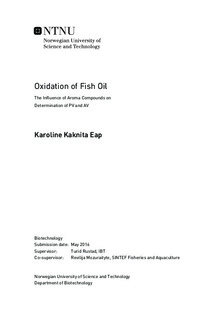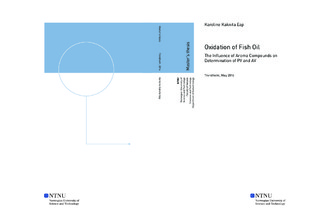| dc.description.abstract | The consumption of fish oil as a nutraceutical has increased extensively in the recent years, due to their high content of health beneficial omega-3 fatty acids. The omega-3 fatty acids in fish oil are highly unsaturated and therefore particularly prone to oxidation, the deterioration reaction that give rise to off-flavors associated with rancid fish oil. Many people find the flavor of fish oil rejecting, thus the industry commonly add fruit flavorings to make the fish oil more appealing.
The most commonly used methods for assessment of oxidation status in fish oil today are peroxide value (PV) method (iodometric titration method) and anisidine value (AV) method that provide determination of primary and secondary oxidation products respectively. Flavorings were recently found to interfere with these traditional methods. The aim of this thesis was to study the influence of flavorings on PV and AV methods further and to investigate if different concentrations of aldehydes in the flavorings give different effects.
The Iodometric Titration Method were found to be affected by the lemon flavorings, giving slightly elevated peroxide values. The interference is possibly caused by the presence of oxidizing compounds in the lemon aroma interfering with the redox method for measuring hydroperoxides. The anisidine value method was found to be highly affected by the aldehydes in the flavorings giving extremely elevated anisidine values. A significant correlation (p < 0.05) between the aldehyde content and the anisidine values was found.
Both PV and AV are widely used methods for determining lipid oxidation status in fish oil, both in industry and research. They are also used as parameters for recommendations of limits of oxidation status by expert organizations and regulatory authorities. Both methods were found to be influenced by compounds that were not part of the lipid oxidation process, and especially the AV method gave highly unreliable results in fish oils with flavoring. There is a need for development and implementation of methods that are less sensitive to aroma compounds for the assessment of oxidations status in flavored fish oils.
The more advanced and specific method, 1H NMR spectroscopy made it possible to distinguish the aldehydes from the aroma and the oxidation-derived aldehydes. The aldehydes from the lemon aroma gave signals in another region than the oxidation-derived aldehydes in the 1H NMR spectrum. Dynamic Headspace GC-MS was used to study the development of volatile secondary oxidation products. An increase in the amount of (E,E)-2,4-heptadienal with storage time was found, but that there was a clear decrease in the amount of the volatiles (E)-2-pentenal, (E)-2-hexenal, (Z)-4-heptenal with storage time was unexpected.. The inconsistency of the findings of development of volatiles shows how complex lipid oxidation and volatile formation in fish oil is and more studies should be performed to study the potential of volatiles serving as parameters of oxidation status in fish oil.
In addition, the influence of some minerals and vitamins on the oxidation process were investigated. Of the minerals Potassium Iodide, Folic Acid, Zink Oxide, Magnesium Oxide and Calcium Carbonate examined using the Oxidative Stability Index method, Calcium Carbonate and Potassium Iodide were found to have small pro-oxidative effects in fish oil without antioxidant, but no effects were observed in fish oil with antioxidant.
The Vitamin K2, Ascorbic Acid, Vitamin A, Vitamin D and Vitamin E were also studied using the Oxidative Stability Index method, and no significant effects were found. A slight anti-oxidative effect was found for Vitamin A and E on the development of secondary oxidation products measured by the anisidine value method in fish oil with and without antioxidant. However, for fish oil without antioxidant, there was observed a pro-oxidative effect at day 20, the last day of measurements, but this effect was not seen in the fish oil with antioxidant. Since the fish oil on the market is always added with antioxidant, these findings are not critical | en |

